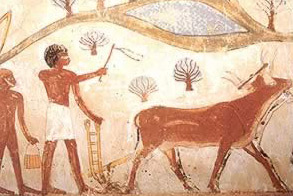The Tomb of Nakht on the West Bank at Luxor
by Jimmy Dunn writing as Mark Andrews
One may wonder, with more Royal tombs and grand temples on the West Bank at Luxor (ancient Thebes), why bother waste time visiting any non-royal tombs. After all, they are much smaller, for the most part, than the grand royal tombs in the Valley of the Kings, and in many cases, the artists who decorated the non-royal tombs could not have been as skilled.

Yet these tombs of the high officials and and nobles of Egypt are practically unique within Egypt. While their decorative plan usually includes religious themes, they also often include scenes of ordinary life and in brilliant colors that could only survive in a tomb. They represent one of our most important sources of information on the lives of the more ordinary Egyptians. In fact, royal tombs can be monotonous, because their decorative plans follow fairly set guidelines. Private tombs can be very diverse.

Farmers Plowing Field with Two Oxen
Nakht was a scribe, holding the title, "Astronomer of Amun" at the Karnak temple during the 18th dynasty. His job was to study the location of stars, the sun and moon in order to schedule festivals and cult rituals for the temple. His wife, Tawy, was a musician of Amun. We know nothing about Nakht and Tawy beyond their tomb, and it is even unclear what king they served under, though some evidence points to Tuthmosis IV.

His tomb is TT 52 on the west bank. It is located within the area of the Abd el-Qurna necropolis. It was apparently discovered by villagers at Qurna prior to being cleared by the Antiquities Service in 1889. In 1917, an English Egyptologists named Norman de Garis Davies and his wife, Nina published information on the tomb which received worldwide attention.

Servant Helping Ladies with Jewelry before the Funerary Banquet
The tomb is unique in that, during the 1980's, experimental restoration and protective measures were employed to preserve the tombs decoration. This process, involving sophisticated technology requiring complete insulation with sheets of glass over all of the vestibule walls (the only part of the tomb that is decorated), ended up being to expensive and difficult for large scale use.

This tomb is not large, and consists of a small corridor, a vestibule, another short corridor and the chapel, which includes a niche for a statue and a shaft.
The decorative plan for this tomb does include religious depictions, showing scenes of offerings and funeral rites. However, their are also paintings of rural life, including the cultivation of grain, digging of small canals for irrigation, harvesting, fishing and and hunting in the Nile Delta. Actually, some of the art work in this tomb is well known.

Entering the vestibule and turning left, towards the entrance's adjoining wall, we first encounter various scenes of country life. At first we see peasants sowing seeds from a container. They are then planted in the ground by a second peasant, using wooden utensils. In the second scene, we find two farmers (see also Peasant Farmers) plowing fields with a wooden plow pulled by two oxen. Finally, we find two groups of peasants tossing grain in the air in order to winnow it. Turning the corner, we find a false door, with paintings of the goddess Nut gathering offerings. The ancient Egyptians believed that the dead could pass through the false door and inhabit statues in order to receive funerary offerings. This idea is reinforced on the door by six offering bearers who, while kneeling, offer water, beer, wine, clothing, unguent, fruit and vegetables. On the left back wall we find paintings of the funerary banquet. The first scene shows a servant helping three ladies with their jewelry. The next scene is very famous, and shows three lady musicians.
On the right rear wall of the vestibule are hunting, fishing and grape harvesting scenes. The first painting is of Nakht's wife, Tawi, holding a small bird. Next there is a double scene, with flocks of rising birds. Nakhjt is portrayed with his wife and two small sons in a papyrus boat, grasping a hunting stick. The next scene is also a double register. The top register shows peasants gathering grapes, while others press them to make wine. In the lower register the days catch of birds are being dragged in a net, while others are sown carefully plucking and cleaning the birds.

Turning the corner once again, we find bearers of offerings and priests before Nakht and his wife. Finally, on the right hand wall back adjacent to the entrance are scenes depicting purification of the offerings before the deceased.

Harvesting Grapes, Top, and the Birds of the Hunt, Bottom

References:
| Title | Author | Date | Publisher | Reference Number |
| Complete Valley of the Kings, The (Tombs and Treasures of Egypt's Greatest Pharaohs) | Reeves, Nicholas; Wilkinson, Richard H. | 1966 | Thames and Hudson Ltd | IBSN 0-500-05080-5 |
| Valley of the Kings | Weeks, Kent R. | 2001 | Friedman/Fairfax | ISBN 1-5866-3295-7 |
| Valley of the Kings | Heyden, A. Van Der | Al Ahram/Elsevier |
Last Updated: June 20th, 2011

